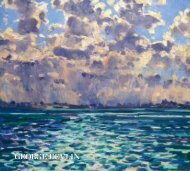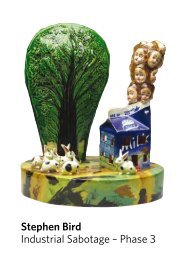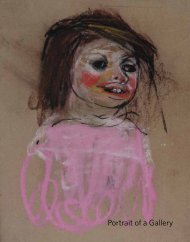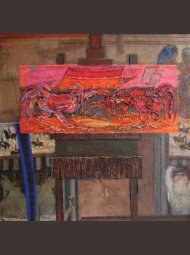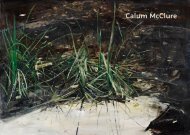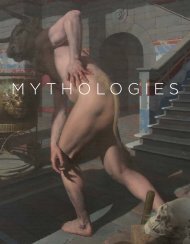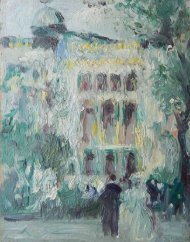Download a PDF of the exhibition catalogue - The Scottish Gallery
Download a PDF of the exhibition catalogue - The Scottish Gallery
Download a PDF of the exhibition catalogue - The Scottish Gallery
You also want an ePaper? Increase the reach of your titles
YUMPU automatically turns print PDFs into web optimized ePapers that Google loves.
<strong>The</strong> Taste <strong>of</strong> JW Blyth<br />
Peter Arkell and Guy Peploe<br />
Origins and beginnings<br />
John Waldegrave Blyth (1873–1962) was a Kirkcaldy linen manufacturer with a passion<br />
for art collecting that began in his early thirties. By <strong>the</strong> time <strong>of</strong> his death he owned 237<br />
paintings including 84 by Samuel John Peploe (1871–1935) and 45 by William McTaggart<br />
(1835–1910). <strong>The</strong>re were also 24 works by Walter Richard Sickert (1860–1942),<br />
examples by Jean-Baptiste-Camille Corot (1796–1875), Eugène Boudin (1824–98) and<br />
Édouard Vuillard (1868–1940), an L.S. Lowry (1887–1976), a Mat<strong>the</strong>w Smith (1879–<br />
1959) and many more. <strong>The</strong> first paintings were bought in 1909 and he was still buying six<br />
years before his death. A large part <strong>of</strong> <strong>the</strong> collection is now in <strong>the</strong> Kirkcaldy Art <strong>Gallery</strong>,<br />
but a very significant portion was retained, and <strong>the</strong> <strong>exhibition</strong> which accompanies this<br />
publication represents <strong>the</strong> last works held by <strong>the</strong> family. It is more than fitting that this<br />
<strong>exhibition</strong> takes place at <strong>The</strong> <strong>Scottish</strong> <strong>Gallery</strong> from where so much <strong>of</strong> <strong>the</strong> collection was<br />
bought and with whom Blyth enjoyed such a long and fruitful relationship. His faith in<br />
<strong>The</strong> <strong>Scottish</strong> <strong>Gallery</strong> over fifty years and four generations <strong>of</strong> senior partners and staff<br />
and <strong>the</strong> access <strong>the</strong> gallery provided to great works <strong>of</strong> art speak <strong>of</strong> an unusually strong<br />
and fruitful relationship between a gallery and a collector. <strong>The</strong> story <strong>of</strong> his collection<br />
and his developing passion for art spans two world wars, <strong>the</strong> Depression and <strong>the</strong> struggle<br />
in Scotland to identify a national school and establish institutions to best represent<br />
<strong>Scottish</strong> art.<br />
<strong>The</strong> family was <strong>of</strong> Fife origin, and his grandfa<strong>the</strong>r, John, moved to Kirkcaldy<br />
in <strong>the</strong> early 1830s and became involved in <strong>the</strong> linen business. Flax was imported from<br />
Germany and <strong>the</strong> Low Countries and improvements to <strong>the</strong> harbour in <strong>the</strong> mid-nineteenth<br />
century greatly enhanced Kirkcaldy’s ability to import jute and flax and export coal and<br />
manufactured products. Linen manufacture had been established in 1672 but was little<br />
more than a cottage industry on <strong>the</strong> outskirts <strong>of</strong> <strong>the</strong> town. By <strong>the</strong> end <strong>of</strong> <strong>the</strong> century John<br />
Blyth’s grandfa<strong>the</strong>r was able to build <strong>the</strong> Hawklymuir Factory on Park Road and was in<br />
charge <strong>of</strong> a substantial, pr<strong>of</strong>itable business.<br />
Blyth’s fa<strong>the</strong>r left <strong>the</strong> firm in <strong>the</strong> 1850s and moved to Lincolnshire to work in a<br />
bakery; bakers were a major market for linen products and this may well have been <strong>the</strong><br />
connection, but for our story most importantly it was here that he met and married<br />
Elizabeth Waldegrave. <strong>The</strong> family returned to Kirkcaldy in <strong>the</strong> 1870s, drawn back into<br />
<strong>the</strong> fold <strong>of</strong> <strong>the</strong> family business, and John, <strong>the</strong> eldest <strong>of</strong> four bro<strong>the</strong>rs and one sister, was<br />
sent to be educated at <strong>the</strong> Kirkcaldy High School. Aged 18, John Waldegrave Blyth left<br />
school and took up a position as a travelling salesman in <strong>the</strong> family firm.<br />
<strong>The</strong>ir firm’s fortunes were based on demand created for linen goods for use in<br />
<strong>the</strong> British military for <strong>the</strong> defence <strong>of</strong> <strong>the</strong> Empire, and procurement contracts for <strong>the</strong><br />
First World War led to a period <strong>of</strong> prosperity which coincided with Blyth’s burgeoning<br />
interest in art. However <strong>the</strong> introduction <strong>of</strong> cotton into Europe, and especially <strong>the</strong><br />
series <strong>of</strong> late-eighteenth-century inventions that enabled it to be spun strongly and<br />
2




